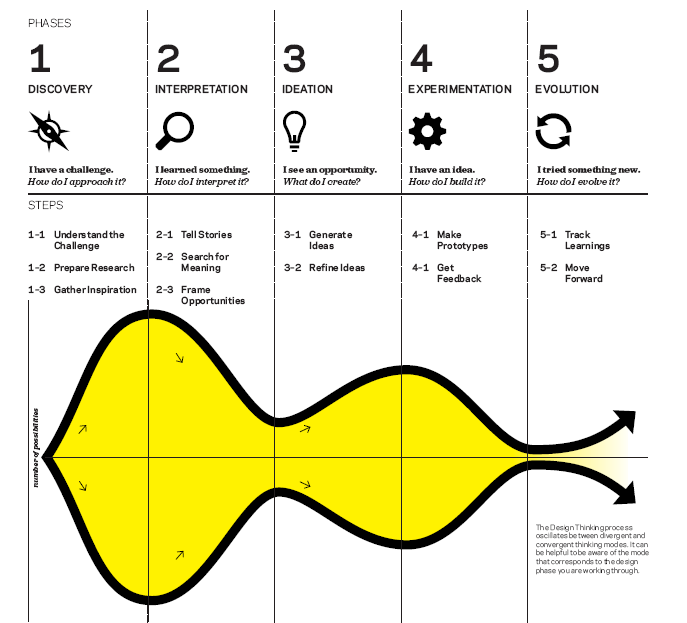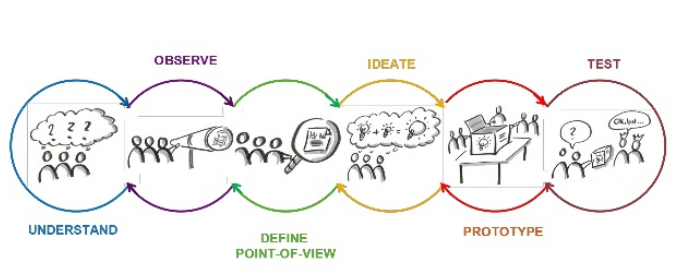 Finally, I am completely surrounded by inspiration, ideation and implementation. I have that feeling of being somewhat overwhelmed, I can’t twist and turn anymore, it simply will not go away.
Finally, I am completely surrounded by inspiration, ideation and implementation. I have that feeling of being somewhat overwhelmed, I can’t twist and turn anymore, it simply will not go away.
Do I throw myself off the building or decide to listen a little longer? It really is forcing me to think.
Today it seems whenever I pick up a business book each chapter has a section on it.
Also, I seem not to be able to not fall over all the articles extolling its virtues, I mindlessly “Google it” and you can see your whole life flash before you, if you decided to investigate this seriously.
What am I talking about?
Well, nothing other than Design Thinking. I know, most of you are so heavily into this you feel you might as well ‘flip’ over to the next article but are you, really?
Design thinking is a mindset
If we believe we can make a difference and even have gone that one step further, many never seem to get there, where we have an intentional process to get us to new relevant solutions that do actually create a positive impact. Then we are getting closer to that ‘magic point’ of transforming ourselves and those complex challenges, into opportunities to be designed and developed to make that difference. Now that would not be such a bad place to be.
Someone has talked me off the ledge, I give in and I want that embracing mindset
- One that allows me to be human-centred where empathy and understanding of others’ needs take precedence.
- One that allows me to be even more collaborative, where I can link my (great) mind with the views of others, those who can bring multiple perspectives into my own thinking.
- A place where optimistic thinking prevails, where you chase for solutions that overcome multiple constraints and the work becomes an enjoyable process.
- Finally, somewhere where it is allowed that you become ’experimental’, given permission to fail and learn from your mistakes. Why? Because you become resilient, you bounce back with different ideas, you seek out important feedback on them, and then you learn to iterate even better than before.
You are a work-in-progress of that forward momentum. You become an experimenter and this ‘magic pill’ called design thinking is all about learning by doing. You begin to believe and gain new confidence that new, better things ARE possible and you can make them happen. That gives you real optimism.
So I’ve come off the ledge, have you?
What will design thinking get you? The chance to be more involved in collaboration, one that permits me to be more creative to boost my confidence and where I can learn new ways to engage with others in a defined process and a process that will help me get unstuck, sounds like it is more fun than where I have been. Maybe somewhere near you, there is a Design Thinking AA group all chanting “one day at a time”.
So what does this Design Thinking process look like?

(Image source: IDEO)
So we need to start learning how to put this design thinking into more everyday practice
Design thinking really is ‘design doing’ or ‘design making’ than simply just thinking. It leads to the upfront framing before solutions are explored. The framing and solutions need to be separated. The pleasure of design thinking is it’s an iterative process, it wants you to experiment, build prototypes to develop your knowledge, go out and test them, talk about them and progressively validate the concept.
It brings ambiguity into a sharper understanding that eventually moves from all the divergence that initially surrounded it, into a growing convergence. It allows you to move from a concept or initial idea, through a number of working hypotheses, eventually into a final product, business model or service, that is not just new to the world but seen as valuable and an improvement on the existing solutions.
The great thing about design thinking: it’s evolving itself
We are relating design thinking to a great set of tools that can help identify and execute opportunities for growth and innovation. Darden Business School has been leading from the front in this, alongside Ideo and if we just consider ten of these, can you within your organization feel comfortable that you are actually applying these in your innovation practices?
These are:
- 1) Visualization
- 2) Journey mapping
- 3) Value Chain analysis
- 4) Mind Mapping
- 5) Rapid concept development
- 6) Assumption testing
- 7) Prototyping
- 8) Customer co-creation
- 9) Learning launches and finally
- 10) Storytelling
How many of these practices are you building into your innovation process to explore and exploit?
I’m very much into Divergent and Convergent thinking
You need both to explore and exploit the multiple possible solutions.
Divergent thinking is the ability and opportunity to offer different, unique or variant ideas adherent to one theme, while convergent thinking is the (eventual) ability to find the ‘correct’ solution to the given problem. You encourage and ideate many solutions, both possible and impossible, and then use convergent thinking to move towards a realizable resolution or solution.
I use this ‘divergent and convergent’ structure for many of my workshops, it allows for broader engagement and involvement and that eventual drawing together from this process. Once or twice you have to be nimble on your feet to move from one to the other but the discipline comes from timing these as shared spaces.
The focus becomes one on Validity
Seeking valid answers is the crux of Design Thinking. The process really is a “knowledge funnel” according to Roger Martin, ex Dean of Rotman School of Management. You keep ‘driving’ towards this eventual ‘validity’ by encouraging a future-oriented view. To think in the ‘future’ we do need to think differently, as most of our minds are caught up in the here and now and that tends to keep us locked in the status quo.
We need to design in a different mindset. Envisaging a future state is not easy, it requires observation, imagination and potential for configuration. We need to seek out patterns; we need to keep re-framing our thinking. Design thinking becomes an essential part of that set of abilities.
So to be relevant, you need design principles

(Image source: IDEO)
If we think about inspiration, ideation and implementation we already lift ourselves out of our everyday. What does it take to seek out and strengthen those higher-impact connections and relationships? What does it take to move beyond the existing and strive to define some more high-impact challenges, then how do we amplify the potential impact?
We need principles, and design thinking can allow you to follow a clear pathway to the realization of better innovation. Can you feel it is beginning to surround you too?
Jump but this time jump into design thinking, it might help you turn your ideas into those things that can really have an impact on your future and your organization.
******
Publishing note: This blog post was originally written on behalf of Hype and with their permission I have republished it on my own site. I recommend you should visit the Hype blog site where they have a range of contributors writing about a wide-ranging mix of ideas and thoughts around innovation, its well worth the visit.
Crikey, Paul, you’ve definitely drunk the Kool-Aid!